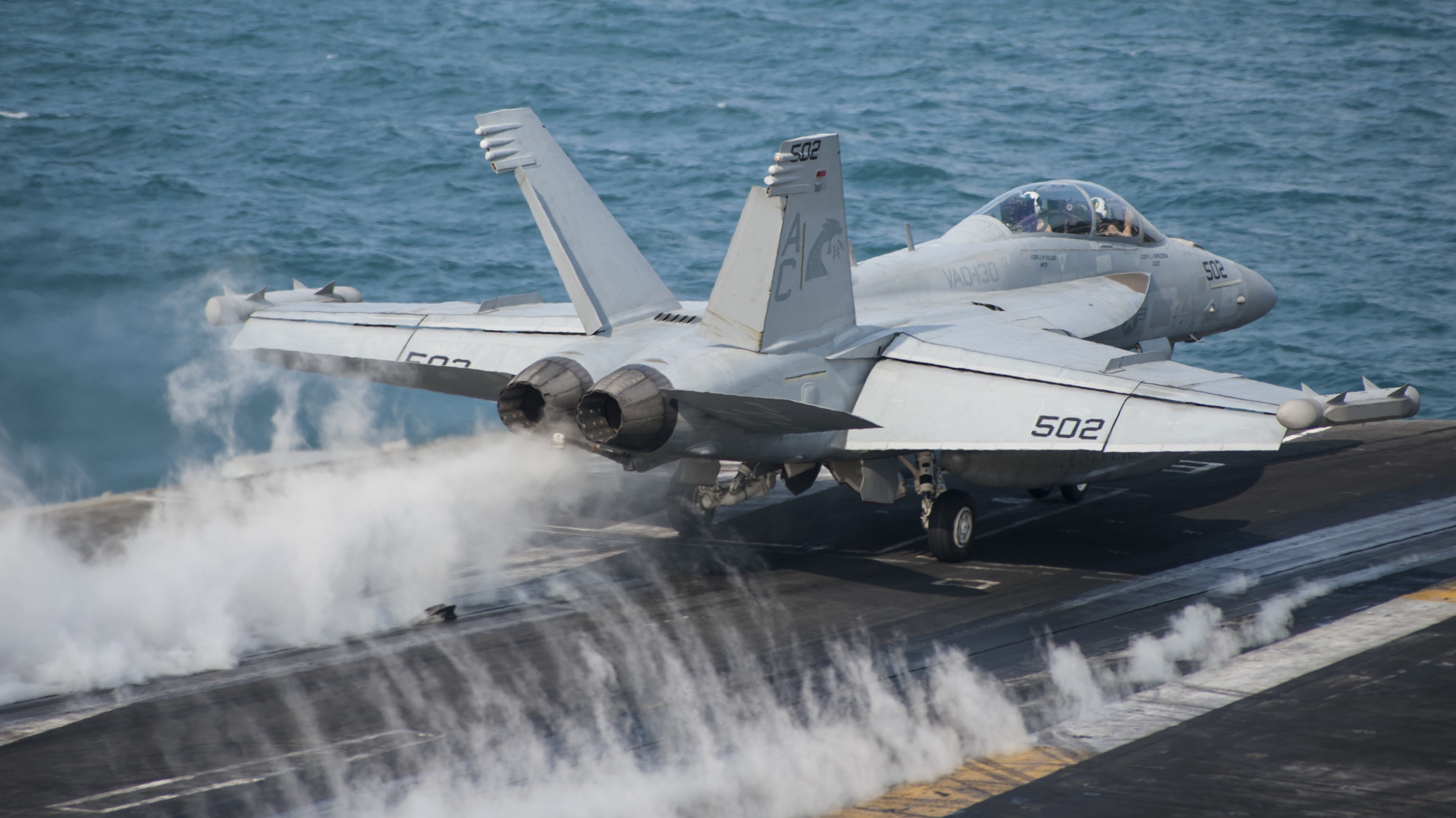
The Navy’s director of air warfare told Congress Wednesday the service might want more electronic attack aircraft to effectively fight a high end joint air war.
The service is asking for 22 additional EA-18G Growlers in the service’s yet-to-be released unfunded requirements list to increase the size of the current EA-18G squadrons to seven aircraft a piece up from the current complement of five jets, Rear Adm. Mike Manazir, the Navy’s director of air warfare, told the House Armed Services Committee on Wednesday.
“We have determined in our campaign analysis that when you increase from five towards eight aircraft, that actually gives us a knee in the curve to reduce the time of the [air] campaign and increase the effectiveness of the electromagnetic maneuver warfare,” he said.
The unfunded request would expand from a planned force of 138 to 160.
“What we are looking at now is a series of studies that look at the validated requirements above 138 EA-18Gs to determine whether the joint fight, the interoperable fight with the Marine Corps, the Navy, the Air Force and our coalition partners requires additional EA-18Gs,” Manazir said.
Without the additional aircraft, the F/A-18E/F Super Hornet and EA-18G line would cease production in 2016.
The EA-18G with its current ALQ-99 jamming pods is able to attack a broad spectrum of electromagnetic frequencies. In the future, that capability will only increase with the introduction of the Raytheon-built Next Generation Jammer (NGJ) pods.
According to the Navy, the new NGJ will greatly increase the capabilities of the EA-18G. “It will significantly increase jamming capability, exercising increased radiated power, rapid beam steering, advanced jammer modulations and increased capacity,” wrote Capt. John Bailey, Naval Air Systems Command’s airborne electronic attack program manager said in a statement to USNI News.
“Additionally, the NGJ Modular Open Systems Architecture (MOSA) allows for rapid hardware and software updates in the future to counter improving threat capabilities at a reduced operational and sustainment cost.”
Many of the NGJ’s capabilities will be thanks to its Gallium Nitride (GaN) based active electronically scanned array antennas. Raytheon’s GaN technology is also an instrumental component of its planned Air and Missile Defense Radar (AMDR) for the Flight III Arleigh Burke (DDG-51) guided missile destroyer.
Additionally, the new pods will be able to perform airborne cyber attacks.
“NGJ will be capable of generating ‘digital payloads’ that could be used against cyber targets,” Bailey wrote.
Right now, the Navy is focused on the first increment of the NGJ—which the mid-band pod.
The next increment focuses on the low-band pod, while third increment would be focused on the high-bands.
“Each of the three increments covers a different frequency band. The order of development, mid, low and then high, was determined by the threat and available capability,” Bailey wrote. “Currently, Increment 1 is the only funded program and covers the most critical threats.”
Meanwhile, the Lockheed Martin F-35 Joint Strike Fighter is also an extremely capable electronic attack platform — but only over a limited part of the spectrum, Manazir said.
The F-35 uses its Northrop Grumman APG-81 for its electronic attack capability and therefore is limited to jamming enemy emitters within its own frequency band.
“The EA [electronic attack] capabilities of the F-35 are designed to support its own strike package in a specific portion of the EM [electromagnetic] spectrum. The EA-18G by design has a much broader and wider application of EA capabilities,” wrote Capt. Scott Conn, who heads the strike branch under Manazir’s office, in a statement to USNI News.
“The EA-18G is utilized as a theater level asset, attacking the full spectrum of threat kill chains from communication systems, surveillance, acquisition, and fire control radars,” Conn wrote.
“The EA capabilities of the F-35 complement the EA-18G, and the synergy between the two are very effective against advanced IADs [integrated air defenses] threats.”
Manazir testified that the EA-18G would be used to support the F-35B and C in their penetrating strike role in an anti-access/area denial environment (A2/AD).
“Stealth provides significant survivability but it does not address the complete kill chain of the threat. The combination of stealth and EA is extremely effective; EA effectiveness is usually based on what is called J/S Jamming signal/Signature signal,” Conn stated, expanding on Manazir’s testimony.
“With stealth [aircraft] the signature is magnitudes lower than conventional [aircraft]. Thus, specific jamming from the EA-18G with ALQ-99 or Next Generation Jammers can be significantly more effective for a stealth [aircraft] than for a conventional [aircraft.]”
Further, the EA-18G would be needed to support a “stand-in” jamming capability, Manazir said. The stand-off jamming would be needed while the “stand-in” jammers penetrate into hostile territory—but Manazir did not elaborate on exactly what that stand-in capability would consist of.





